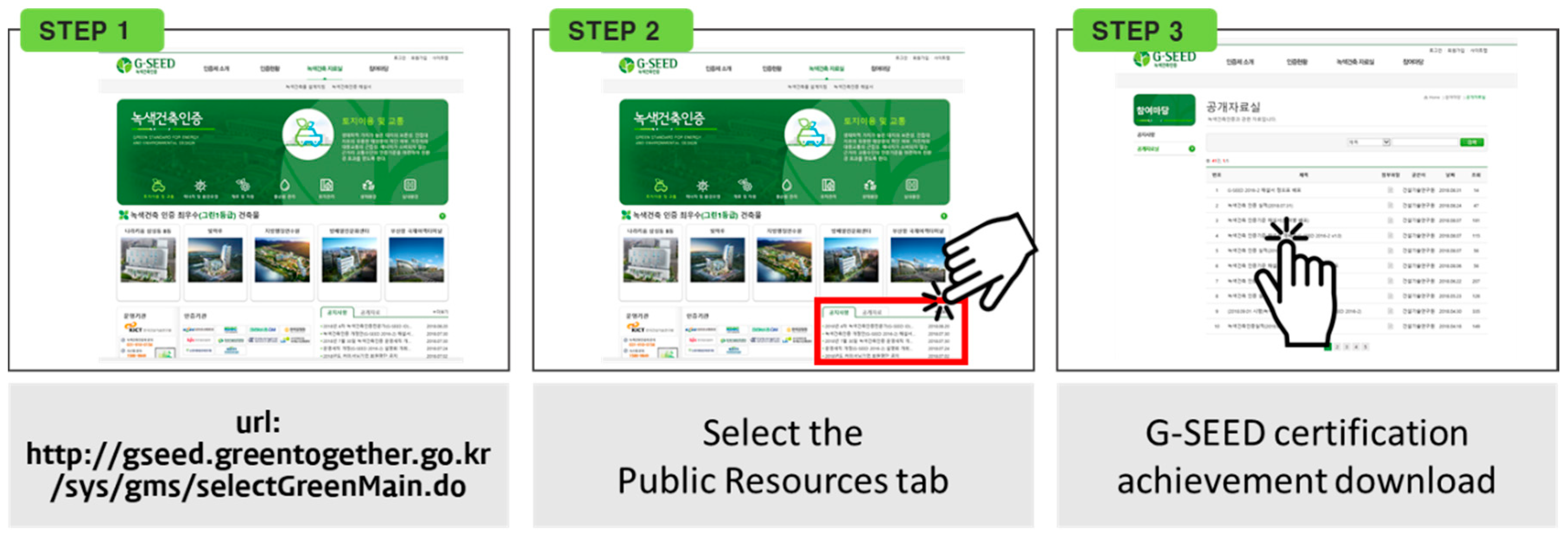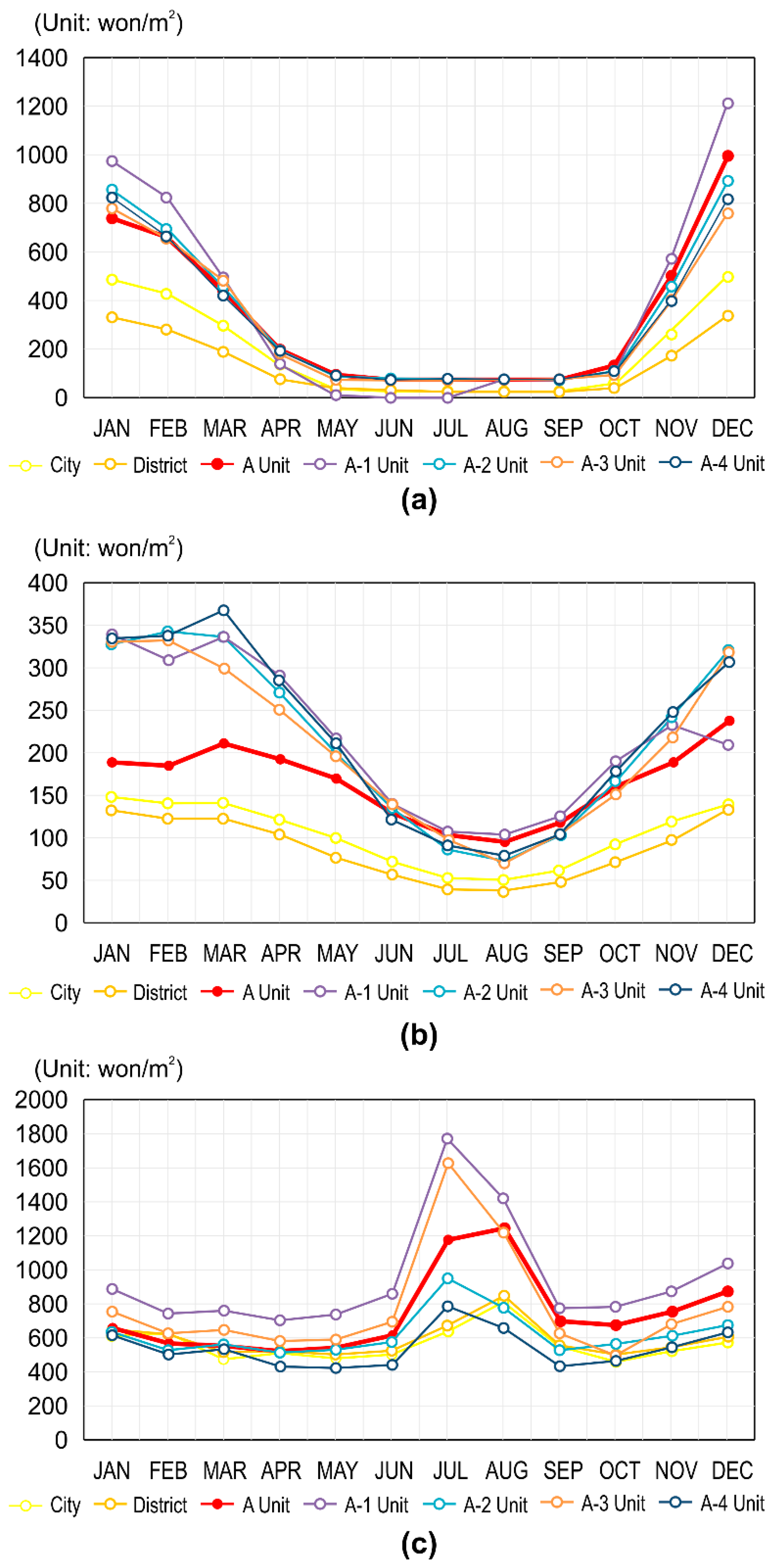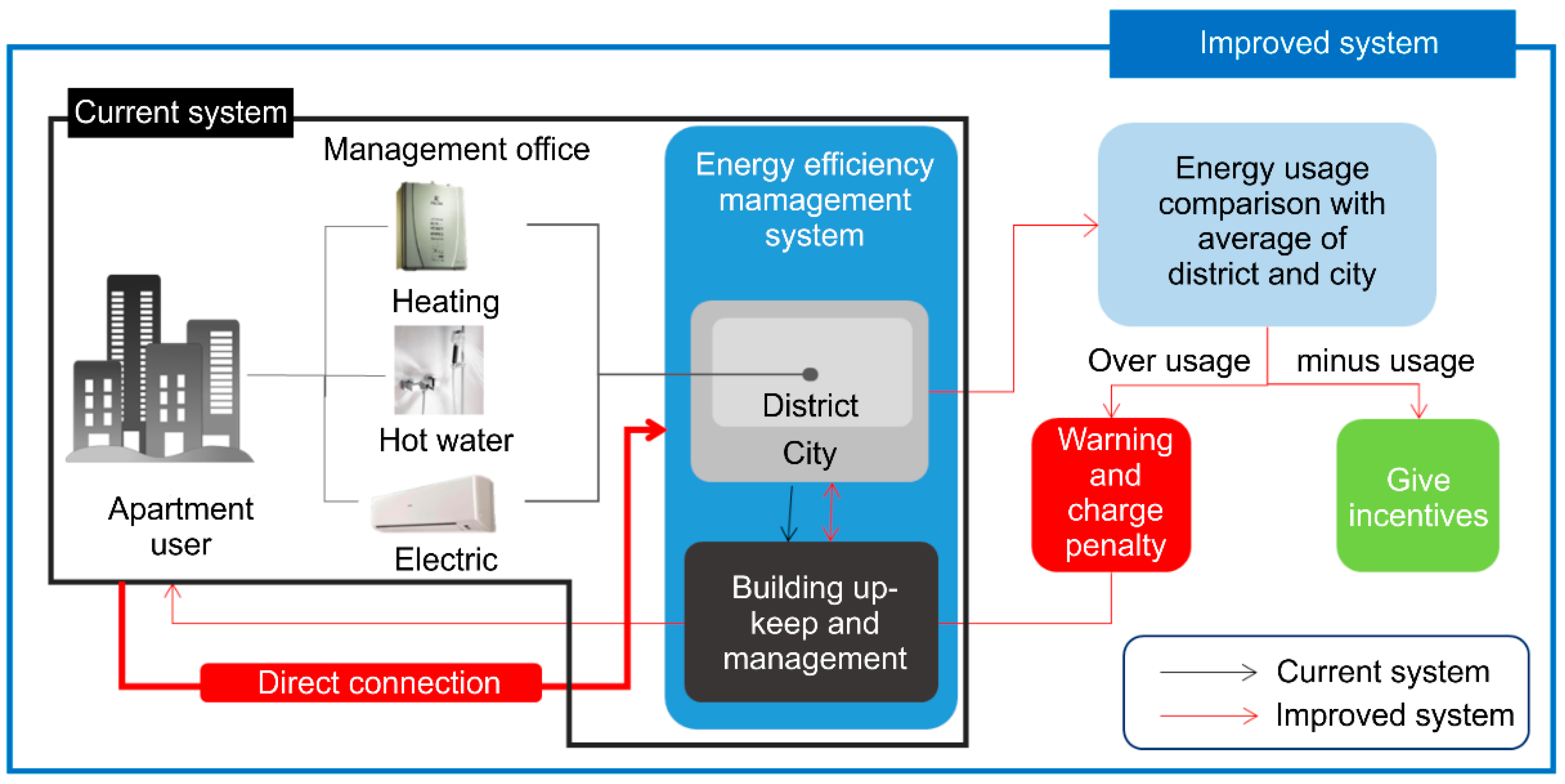A Study of the Energy Efficiency Management in Green Standard for Energy and Environmental Design (G-SEED)-Certified Apartments in South Korea
Abstract
:1. Introduction
2. Theoretical Consideration
2.1. Green Building Certification System in South Korea
2.2. Management of Efficient Energy Systems Internationally
3. Analysis of Energy Efficiency during Management in G-SEED-Certified Apartments
3.1. Outline of Energy Efficiency Analysis
3.1.1. Process of Unit Selection
3.1.2. Survey Content
3.2. Energy Efficiency Status Analysis
3.3. Discussion
4. Improvement Plan to Increase Energy Efficiency in Apartments
4.1. Analysis of Energy Management System in South Korea (G-SEED)
4.2. Analysis of Energy Efficiency Management Systems Internationally
4.2.1. Efficiency Guidelines for Buildings in the European Union (EPBD)
4.2.2. Major Industrial Countries (U.S.A. (Energy Star), Japan (CASBEE))
4.3. Improvement Plan for Energy Efficiency Management System of Apartments
5. Conclusions
Author Contributions
Funding
Acknowledgments
Conflicts of Interest
References
- United Nations Framework Convention on Climate Change, The Paris Agreement. Available online: http://unfccc.int/paris_agreement/items/9485.php, 2018 (accessed on 7 June 2018).
- Ministry of Land, Infrastructure, and Transport (MOLIT). POST-2020 Planning on Development of Greenhouse Gas Reduction in Building Sector; MOLIT: Sejong-city, Korea, 2016.
- Office for Government Policy Coordination; Prime Minister’s Secretariat; Greenhouse Gas Inventory & Research Center. National Greenhouse Gas Inventory Report of Korea; Office for Government Policy Coordination: Seoul, Korea, 2016.
- Building Research Establishment (BRE). Environmental Assessment Method, BREEAM New Construction Technical Manual; BRE: Hong Kong, China, 2011. [Google Scholar]
- United States Green Building Council (USGBC). LEED Reference Guide for Building Design and Construction; USGBC: Washington, DC, USA, 2013. [Google Scholar]
- United States Green Building Council (USGBC). LEED v4 User Guide; USGBC: Washington, DC, USA, 2014. [Google Scholar]
- Ministry of Land, Infrastructure, and Transport (MOLIT). Law of Supporting Green Building; Ministry of Government Legislation; National Law Information Center: Sejong-city, Korea, 2016. Available online: http://www.law.go.kr/lsSc.do?menuId=0&subMenu=1&query=%EB%85%B9%EC%83%89%EA%B1%B4%EC%B6%95%EB%B2%95#undefined, 2016 (accessed on 24 September 2017).
- Thatcher, A.; Milner, K. Is a green building really better for building occupants? A longitudinal evaluation. Build. Environ. 2016, 108, 194–206. [Google Scholar] [CrossRef]
- Khoshbakht, M.; Goua, Z.; Lu, Y.; Xie, X.; Zhang, J. Are green buildings more satisfactory? A review of global evidence. Habitat Int. 2018, 74, 57–65. [Google Scholar] [CrossRef]
- Jeong, J.; Hong, T.; Ji, C.; Kim, J.; Lee, M.; Jeong, K. Development of an evaluation process for green and non-green buildings focused on energy performance of G-SEED and LEED. Build. Environ. 2016, 105, 172–184. [Google Scholar] [CrossRef]
- Ingrao, C.; Messineo, A.; Beltramo, R.; Yigitcanlar, T.; Ioppolo, G. How can life cycle thinking support sustainability of buildings? Investigating life cycle assessment applications for energy efficiency and environmental performance. J. Clean. Prod. 2018, 556–569. [Google Scholar] [CrossRef]
- Tronchin, L.; Manfren, M.; Nastasi, B. Energy efficiency, demand side management and energy storage technologies—A critical analysis of possible paths of integration in the built environment. Renew. Sustain. Energy Rev. 2018, 95, 341–353. [Google Scholar] [CrossRef]
- Lee, J.; Shepley, M. Analysis of human factors in a building environmental assessment system in Korea: Resident perception and the G-SEED for MF scores. Build. Environ. 2018, 142, 388–397. [Google Scholar] [CrossRef]
- Paone, A.; Bacher, J.P. The Impact of Building Occupant Behavior on Energy Efficiency and Methods to Influence It: A Review of the State of the Art. Energies 2018, 11, 953. [Google Scholar] [CrossRef]
- Lee, N.; Tae, S.; Gong, Y.; Roh, S. Integrated building life-cycle assessment model to support South Korea’s green building certification system. Renew. Sustain. Energy Rev. 2017, 76, 43–50. [Google Scholar] [CrossRef]
- Chet, I.M.; Illa, S.; Tam, V.W.Y.; Le, K.N.; Shen, L. Key credit criteria among international green building rating tools. J. Clean. Prod. 2017, 164, 209–220. [Google Scholar] [CrossRef]
- Shan, M.; Hwang, B. Green building rating systems: Global reviews of practices and research efforts. Sustain. Cities Soc. 2018, 39, 172–180. [Google Scholar] [CrossRef]
- Geis, S.; Oster, D.; Mach, E. Transition towards Energy Efficiency: Developing the Nigerian Building Energy Efficiency Code. Sustainability 2018, 10, 2620. [Google Scholar] [CrossRef]
- Dwai, L.N.; Ali, K.N. The economic benefits of a green building—Evidence from Malaysia. J. Build. Eng. 2018, 18, 448–453. [Google Scholar] [CrossRef]
- Wu, X.; Peng, B.; Lin, B. A dynamic life cycle carbon emission assessment on green and non-green buildings in China. Energy Build. 2017, 149, 272–281. [Google Scholar] [CrossRef]
- Enke, R.A.; Morrison, G.M. Analysis of the transition effects of building codes and regulations on the emergence of a low carbon residential building sector. Energy Build. 2017, 156, 40–50. [Google Scholar] [CrossRef]
- Garcia, A.; Cumo, D.; Tiberi, F.; Sforzini, M.; Piras, V.; Cost-Benefit, G. Analysis for Energy Management in Public Buildings: Four Italian Case Studies. Energies 2016, 9, 522. [Google Scholar] [CrossRef]
- G-SEED, Korea Green Building Certification System (G-SEED) Support System. Available online: http://gseed.greentogether.go.kr/sys/gms/selectGreenMain.do, 2017 (accessed on 7 June 2018).
- Statistics Korea, Building Status. Available online: http://www.index.go.kr/potal/main/EachDtlPageDetail.do?idx_cd=1226, 2017 (accessed on 8 June 2018).
- Apartment Management Info System. Available online: http://www.k-apt.go.kr, 2009 (accessed on 8 June 2018).
- Oh, Y. Management Status and Suggestions for Improvement of Environment-Friendly Features in GBCS-Certified Apartment Communities. Master’s Thesis, Chungbuk National, Cheongju, Korea, 2011. Available online: http://www.riss.kr/link?id=T12368104 (accessed on 2 September 2018).
- Kang, B. Management Status Analysis in GBCS Certified Housing Complexes. Master’s Thesis, University of Seoul, Seoul, Korea, 2013. Available online: www.riss.kr/link?id=T13234955 (accessed on 2 September 2018).
- Energy Star, Energy Star Overview. 2018. Available online: https://www.energystar.gov/about (accessed on 4 April 2018).
- Office of Air and Radiation, Climate Protection Partnerships Division, National Awareness of ENERGY STAR® for 2016, Analysis of 2016 CEE Household Survey. 2017. Available online: https://www.energystar.gov/awareness (accessed on 4 April 2018).
- CASBEE for New Construction, Technical Manual. 2014. Available online: http://www.ibec.or.jp/CASBEE/english/download/CASBEE-BD(NC)e_2014manual.pdf (accessed on 4 April 2018).
- United States Green Building Council. 2018. Available online: http://www.usgbc.org/home (accessed on 25 March 2018).
- EnergyPlus, Energy Plus Engineering Reference. 2015. Available online: https://energyplus.net/sites/default/files/pdfs_v8.3.0/EngineeringReference.pdf (accessed on 4 April 2018).
- Kim, M. Characteristics and determinants by electricity consumption level of households in Korea. Energy Repos 2018, 4, 70–76. [Google Scholar] [CrossRef]
- Kim, H.; Park, W. A Comparison Analysis on the Changes in Energy Efficiency of the G-SEED Certified Apartment Buildings. J. Reg. Assoc. Archit. Inst. Korea 2016, 18, 171–182. [Google Scholar]
- Yeong, J.; der Über, Y. Europäischen Instrumente zur Energieeinsparung im Gebäudebereich. Korean Environ. Law Assoc. 2011, 33, 167–198. [Google Scholar]
- European Commission, EU Action Against Climate Change: Leading Global Action to 2020 and Beyond. 2008. Available online: https://ec.europa.eu/clima/sites/campaign/pdf/post_2012_en.pdf (accessed on 8 June 2018).
- UK Government, Energy Performance Certificate. 2009. Available online: https://www.gov.uk/government/uploads/system/uploads/attachment_data/file/49997/1790388.pdf (accessed on 26 June 2018).












| Management of Efficient Energy Systems Internationally | Management of Efficient Energy Systems in South Korea | ||||
|---|---|---|---|---|---|
| Classification | * Europe The Energy Performance of Buildings Directive [4,5,6,31,32] | U.S.A. Energy Star [28,29] | Japan Comprehensive Assessment System for Built Environment Efficiency [30] | Green Standard for Energy and Environmental Design [23] | Building Energy Efficiency Certification System [1] |
| Target | All building types | Residential and non-residential buildings | Offices, schools, sales facilities, restaurants, meeting facilities, factories, hospitals, hotels, residential | Common houses, complex buildings (residential), business buildings, hotels, sale facilities, schools | Apartments and commercial buildings |
| Range for evaluation | Energy performance, building hardware for improving housing efficiency | Evaluation of overall performance of building | Evaluation of environmental performance of building | Evaluation of overall performance of building | Energy reduction rate |
| Evaluation items |
|
|
|
|
|
| Certification grade | Not classified | 4 grades | 5 grades | 4 grades | 10 grades |
| Selection Criteria of Target Area | Selected Area | |
|---|---|---|
| Level 1 | • Green Standard of Energy and Environmental Design main certification area | 77 |
| • Benefits of incentive received | ||
| Level 2 | • No townhouse or multiplex house types | 24 |
| • No dormitory or office housing | ||
| Level 3 | • Three years after completion of the building | 6 |
| • Current energy consumption is disclosed, as is the energy consumption analysis area |
| Unit | A | B | C | D | E | F | |
|---|---|---|---|---|---|---|---|
| Corridor type | Stair-type | Stair-type | Stair-type | Stair-type | Stair-type | Stair-type | |
| Heating system | District heating | District heating | District heating | District heating | District heating | District heating | |
| Incentive | Acquisition tax | Floor area ratio | Acquisition tax | Value added tax | Acquisition tax | Acquisition tax | |
| Rating of Green Standard of Energy and Environmental Design certification | Energy efficiency grade | 2nd grade | 3rd grade | 3rd grade | 1st grade | 2nd grade | 2nd grade |
| Main certification | Green 2nd grade | Green 2nd grade | Green 2nd grade | Green 2nd grade | Green 2nd grade | Green 2nd grade | |
| Evaluation of the annual energy consumption of the building | Electricity power | B | - | - | - | C, D | - |
| Thermal energy | A, B | - | - | - | A | - | |
| A | A-1 | A-2 | A-3 | A-4 | |
|---|---|---|---|---|---|
| Completion date | 2013.05 | 2013.04 | 2012.08 | 2013.02 | 2012.08 |
| Number of households | 751 | 766 | 734 | 828 | 754 |
| Green Standard of Energy and Environmental Design | Main certification | Main certification | Main certification | No | No |
| Green 2nd grade | Green 2nd grade | Green 2nd grade | - | - | |
| Number of floors | 57 | 57 | 30 | 42 | 30 |
| Corridor type | Stair-type | Tower-type | Stair-type | Stair-type | Stair-type |
| Heating system | District heating | District heating | District heating | District heating | District heating |
| Calculating ways of apartment energy usage | Remote control | Remote control | Remote control | Remote control | Remote control |
| Total floor area (m2) | 153,075.38 | 154,318.11 | 161,556.67 | 197,266.51 | 152,697.45 |
| Building-to-land ratio | 221% | 221% | 219% | 313% | 219% |
| Floor area ratio | 9% | 8% | 12% | 26% | 13% |
| Number of building parts | 4 | 4 | 7 | 7 | 7 |
| D | D-1 | D-2 | |
|---|---|---|---|
| Completion date | 2014.04 | 2013.12 | 2014.10 |
| Number of households | 955 | 696 | 866 |
| Green Standard of Energy and Environmental Design | Main certification | No | Main certification |
| Green 2nd grade | - | Green 3rd grade | |
| Number of floors | 29 | 15 | 30 |
| Corridor type | Stair-type | Stair-type | Stair-type |
| Heating system | District heating | District heating | District heating |
| Calculating ways of apartment energy usage | Remote control | Remote control | Remote control |
| Total floor area (m2) | 161,666.006 | 92,622.9476 | 141,411.0728 |
| Building-to-land ratio | 172% | 154% | 177% |
| Floor area ratio | 12% | 17% | 12% |
| Number of building parts | 11 | 10 | 13 |
| Heating | Hot Water | Electricity | |||||||
|---|---|---|---|---|---|---|---|---|---|
| Surrounding Unit Average | District Average | City Average | Surrounding Unit Average | District Average | City Average | Surrounding Unit Average | District Average | City Average | |
| A | ↓ | ↑↑↑ | ↑↑↑ | ↓ | ↑↑ | ↑↑ | ↑ | ↑↑ | ↑↑↑ |
| B | ↑ | ↑ | ↑↑↑ | ↓ | ↑ | ↑↑↑ | ↓ | ↑↑↑ | ↑↑↑ |
| C | ↓ | ↓ | ↑↑ | ↓ | ↑ | ↑↑↑ | ↓ | ↑↑ | ↑↑ |
| D | ↓ | - | ↑ | ↑ | - | ↑ | ↓ | - | ↑ |
| E | - | ↑ | ↑↑↑ | - | ↑↑↑ | ↑↑↑ | - | ↑↑↑ | ↑↑↑ |
| F | - | ↑↑↑ | ↑↑ | - | ↑↑↑ | ↑↑↑ | - | ↑↑↑ | ↑↑↑ |
© 2018 by the authors. Licensee MDPI, Basel, Switzerland. This article is an open access article distributed under the terms and conditions of the Creative Commons Attribution (CC BY) license (http://creativecommons.org/licenses/by/4.0/).
Share and Cite
Kim, H.; Park, W. A Study of the Energy Efficiency Management in Green Standard for Energy and Environmental Design (G-SEED)-Certified Apartments in South Korea. Sustainability 2018, 10, 3402. https://doi.org/10.3390/su10103402
Kim H, Park W. A Study of the Energy Efficiency Management in Green Standard for Energy and Environmental Design (G-SEED)-Certified Apartments in South Korea. Sustainability. 2018; 10(10):3402. https://doi.org/10.3390/su10103402
Chicago/Turabian StyleKim, Hyemi, and Wonjun Park. 2018. "A Study of the Energy Efficiency Management in Green Standard for Energy and Environmental Design (G-SEED)-Certified Apartments in South Korea" Sustainability 10, no. 10: 3402. https://doi.org/10.3390/su10103402
APA StyleKim, H., & Park, W. (2018). A Study of the Energy Efficiency Management in Green Standard for Energy and Environmental Design (G-SEED)-Certified Apartments in South Korea. Sustainability, 10(10), 3402. https://doi.org/10.3390/su10103402





